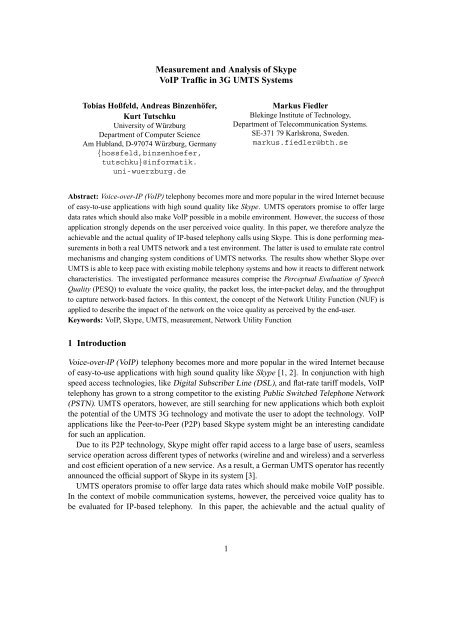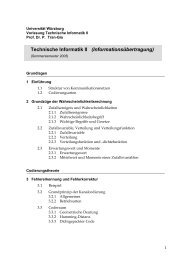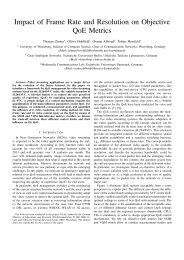Measurement and Analysis of Skype VoIP Traffic in 3G UMTS Systems
Measurement and Analysis of Skype VoIP Traffic in 3G UMTS Systems
Measurement and Analysis of Skype VoIP Traffic in 3G UMTS Systems
You also want an ePaper? Increase the reach of your titles
YUMPU automatically turns print PDFs into web optimized ePapers that Google loves.
<strong>Measurement</strong> <strong>and</strong> <strong>Analysis</strong> <strong>of</strong> <strong>Skype</strong><strong>VoIP</strong> <strong>Traffic</strong> <strong>in</strong> <strong>3G</strong> <strong>UMTS</strong> <strong>Systems</strong>Tobias Hoßfeld, Andreas B<strong>in</strong>zenhöfer,Kurt TutschkuUniversity <strong>of</strong> WürzburgDepartment <strong>of</strong> Computer ScienceAm Hubl<strong>and</strong>, D-97074 Würzburg, Germany{hossfeld,b<strong>in</strong>zenhoefer,tutschku}@<strong>in</strong>formatik.uni-wuerzburg.deMarkus FiedlerBlek<strong>in</strong>ge Institute <strong>of</strong> Technology,Department <strong>of</strong> Telecommunication <strong>Systems</strong>.SE-371 79 Karlskrona, Sweden.markus.fiedler@bth.seAbstract: Voice-over-IP (<strong>VoIP</strong>) telephony becomes more <strong>and</strong> more popular <strong>in</strong> the wired Internet because<strong>of</strong> easy-to-use applications with high sound quality like <strong>Skype</strong>. <strong>UMTS</strong> operators promise to <strong>of</strong>fer largedata rates which should also make <strong>VoIP</strong> possible <strong>in</strong> a mobile environment. However, the success <strong>of</strong> thoseapplication strongly depends on the user perceived voice quality. In this paper, we therefore analyze theachievable <strong>and</strong> the actual quality <strong>of</strong> IP-based telephony calls us<strong>in</strong>g <strong>Skype</strong>. This is done perform<strong>in</strong>g measurements<strong>in</strong> both a real <strong>UMTS</strong> network <strong>and</strong> a test environment. The latter is used to emulate rate controlmechanisms <strong>and</strong> chang<strong>in</strong>g system conditions <strong>of</strong> <strong>UMTS</strong> networks. The results show whether <strong>Skype</strong> over<strong>UMTS</strong> is able to keep pace with exist<strong>in</strong>g mobile telephony systems <strong>and</strong> how it reacts to different networkcharacteristics. The <strong>in</strong>vestigated performance measures comprise the Perceptual Evaluation <strong>of</strong> SpeechQuality (PESQ) to evaluate the voice quality, the packet loss, the <strong>in</strong>ter-packet delay, <strong>and</strong> the throughputto capture network-based factors. In this context, the concept <strong>of</strong> the Network Utility Function (NUF) isapplied to describe the impact <strong>of</strong> the network on the voice quality as perceived by the end-user.Keywords: <strong>VoIP</strong>, <strong>Skype</strong>, <strong>UMTS</strong>, measurement, Network Utility Function1 IntroductionVoice-over-IP (<strong>VoIP</strong>) telephony becomes more <strong>and</strong> more popular <strong>in</strong> the wired Internet because<strong>of</strong> easy-to-use applications with high sound quality like <strong>Skype</strong> [1, 2]. In conjunction with highspeed access technologies, like Digital Subscriber L<strong>in</strong>e (DSL), <strong>and</strong> flat-rate tariff models, <strong>VoIP</strong>telephony has grown to a strong competitor to the exist<strong>in</strong>g Public Switched Telephone Network(PSTN). <strong>UMTS</strong> operators, however, are still search<strong>in</strong>g for new applications which both exploitthe potential <strong>of</strong> the <strong>UMTS</strong> <strong>3G</strong> technology <strong>and</strong> motivate the user to adopt the technology. <strong>VoIP</strong>applications like the Peer-to-Peer (P2P) based <strong>Skype</strong> system might be an <strong>in</strong>terest<strong>in</strong>g c<strong>and</strong>idatefor such an application.Due to its P2P technology, <strong>Skype</strong> might <strong>of</strong>fer rapid access to a large base <strong>of</strong> users, seamlessservice operation across different types <strong>of</strong> networks (wirel<strong>in</strong>e <strong>and</strong> <strong>and</strong> wireless) <strong>and</strong> a serverless<strong>and</strong> cost efficient operation <strong>of</strong> a new service. As a result, a German <strong>UMTS</strong> operator has recentlyannounced the <strong>of</strong>ficial support <strong>of</strong> <strong>Skype</strong> <strong>in</strong> its system [3].<strong>UMTS</strong> operators promise to <strong>of</strong>fer large data rates which should make mobile <strong>VoIP</strong> possible.In the context <strong>of</strong> mobile communication systems, however, the perceived voice quality has tobe evaluated for IP-based telephony. In this paper, the achievable <strong>and</strong> the actual quality <strong>of</strong>1
















